Best guitar stands and hangers 2025: Keep your precious guitars safe and secure
From multi-guitar racks to compact stands and wall hangers, here are the best products from K&M, Hercules, Taylor, Ibanez & more
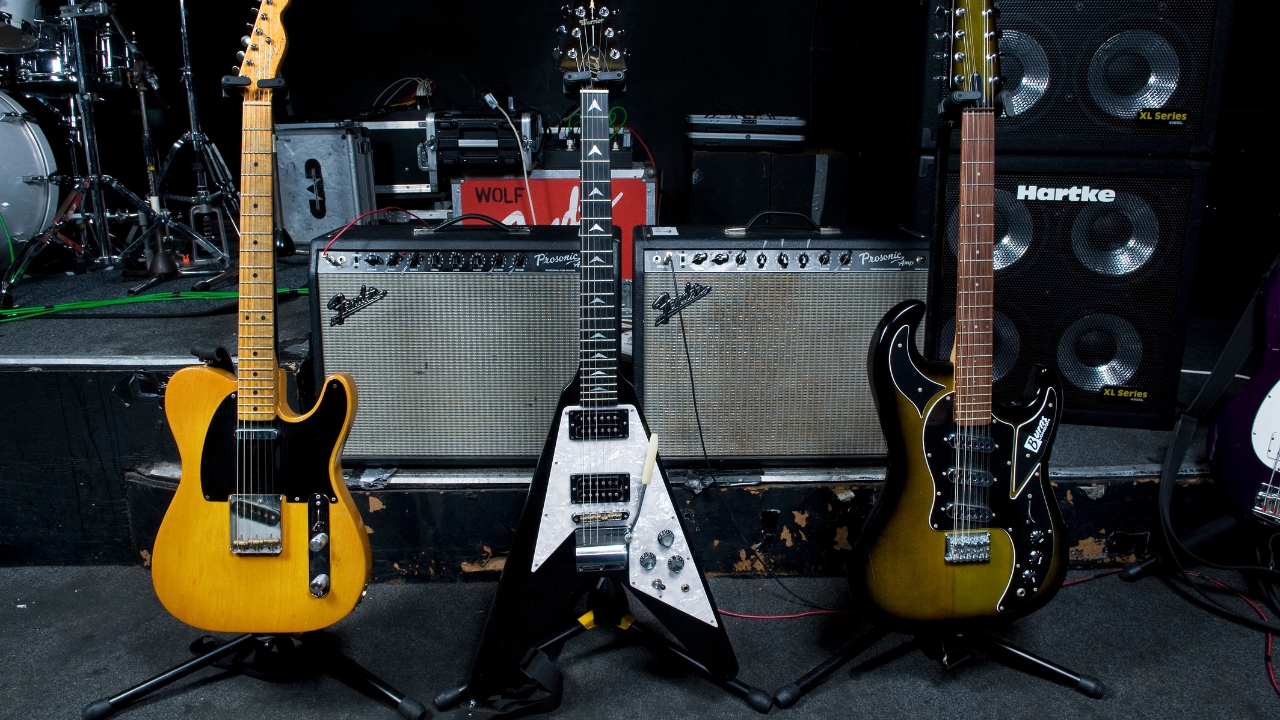
I've always thought the best guitar stands and hangers are essential for keeping your guitar safe, secure, and ready to play. While placing your guitar in a hard case is still the most protective option, at home, it doesn't encourage spontaneous playing, and the impracticality often outweighs the need for maximum security.
In my day job at a busy guitar store, stands and hangers are our bread and butter. They're easily the most requested accessory, and I've helped everyone from first-time buyers to collectors with walls of instruments find the right option. Sometimes that means a simple, no-fuss stand for a first guitar, perhaps a multi-guitar rack for both electrics and acoustics, and often something nitrocellulose-safe for displaying that dream instrument. Wall hangers, meanwhile, clear floor space and are perfect for smaller rooms, while compact stands fold for travel.
With so many choices, it can be tough to know which way to go, but if you're looking for my top pick straight away, then I've gone for the excellent Hercules GSP38WB thanks to its robust build quality and space-saving design. For those with multiple guitars, you should check out the K&M Guardian stand which holds 5 guitars securely.
Further down the page you'll find a how to choose section for complete beginners, alongside a curated FAQ section which will answer any queries you might have. I've also included a glossary of key terms in case you're getting your head spun by any of the stand-specific terms used in this guide.
My top picks
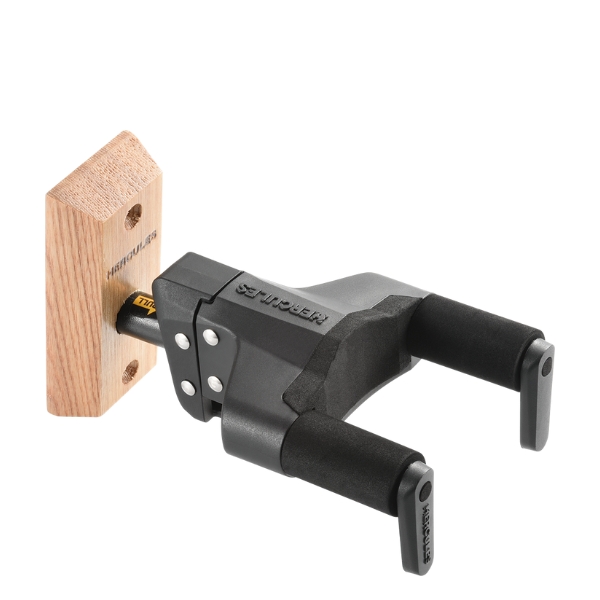
The Hercules hanger comes with a nice-looking wooden base and will suit most decors. The front has two small arms that move upwards to lock the instrument in place when the weight is rested on it. This helps prevent it from falling off due to accidental bumps or knocks – it’s nice to have a bit more peace of mind.
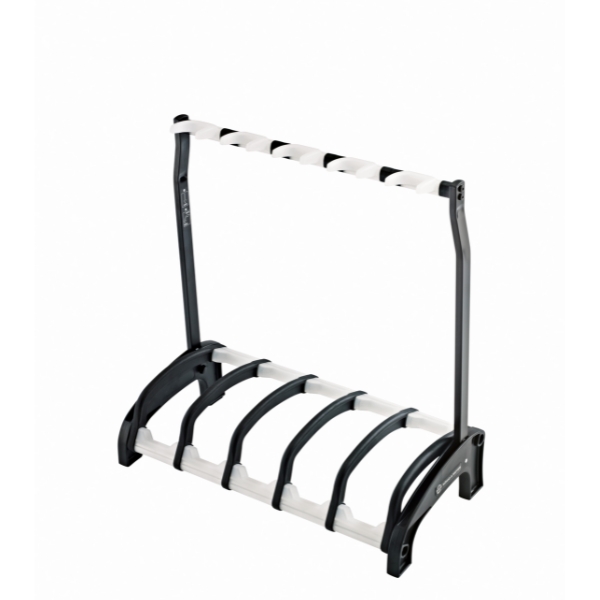
If you’ve got multiple expensive guitars, then the sturdy K&M Guardian is the best way to have them on display, ready to use. Like the smaller version, the contact points on this rack contain no dye and are covered in a non-marring material, so no marks or burns on the surface of your instrument.
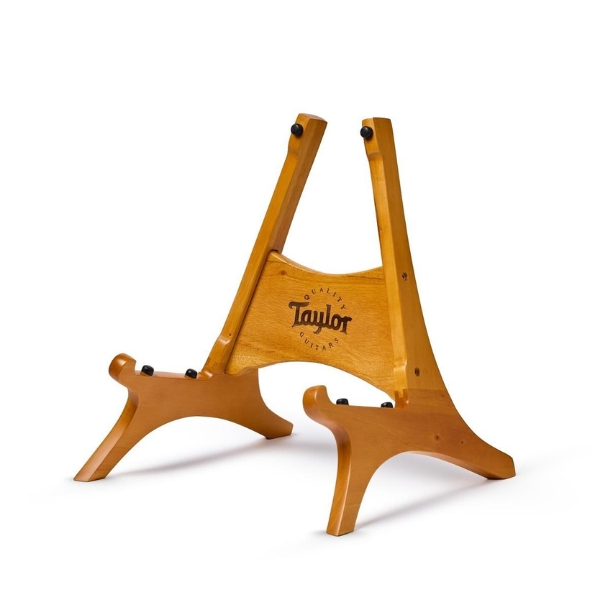
Available in two shades of mahogany, this acoustic guitar stand pairs perfectly with the natural color and aesthetic of your guitar and living space. Rubber pads in each of the cradle rests and at the top of the stand ensure your finish is safe from any scratches.
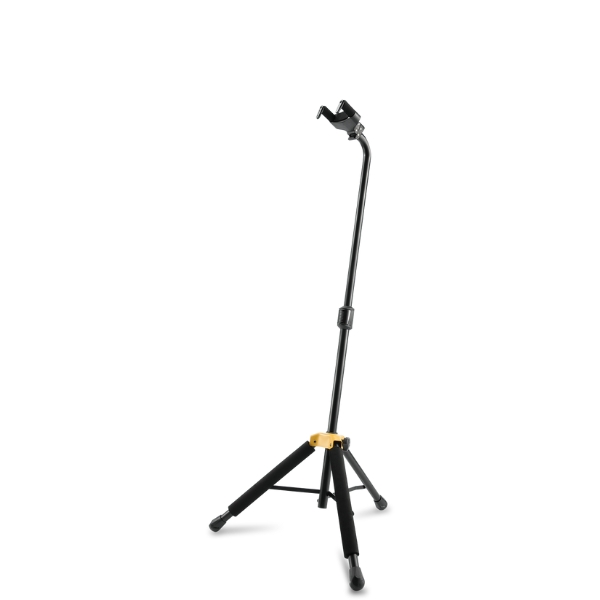
If you’re not too concerned about a stand being super portable, then the Hercules GS414B Plus is well worth considering. The three legs give stability, but the rubber feet create more friction against the ground. Special mention goes to the auto-grab feature that Hercules stands are well known for.
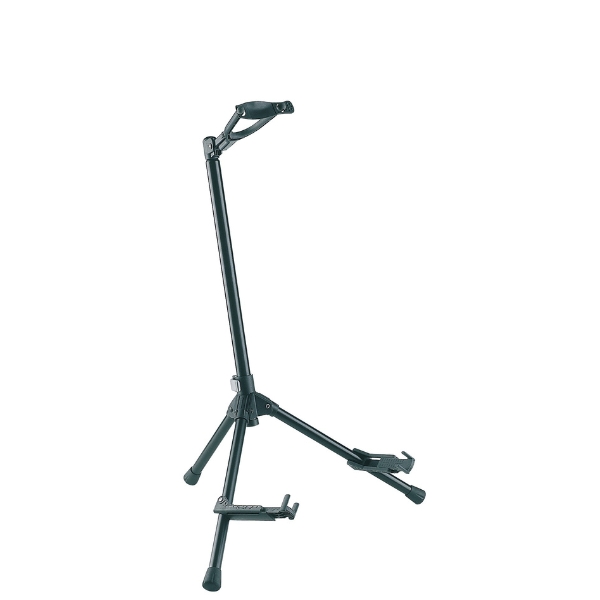
The K&M 17685 Memphis 20's solid build quality ensures it can carry heavier instruments, and I love its adaptability in fitting a variety of different instrument shapes. It has a hanging system alongside two instrument support arms, making it ultra-solid, and its height is adjustable to accommodate different instrument scale lengths.
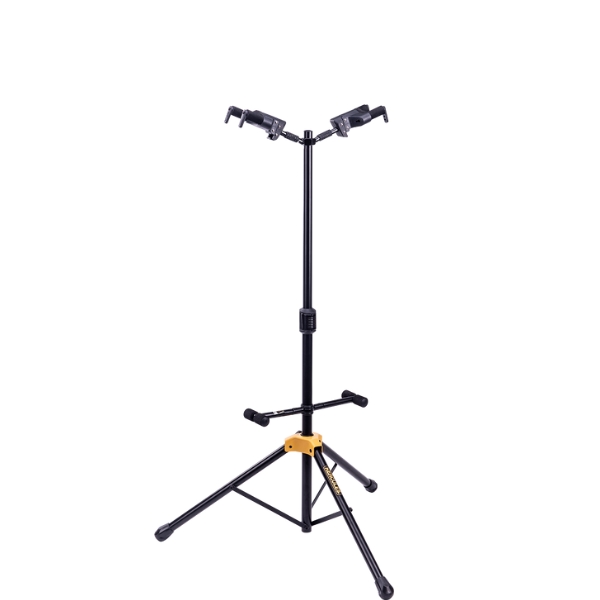
The Hercules GS422B PLUS is designed to hold two guitars back to back and this sturdy stand offers the rugged build quality and stability we've come to expect from Hercules. It folds so you can take it to shows but I've heard of them falling over with only one guitar on the stand, so do be careful.
Best overall
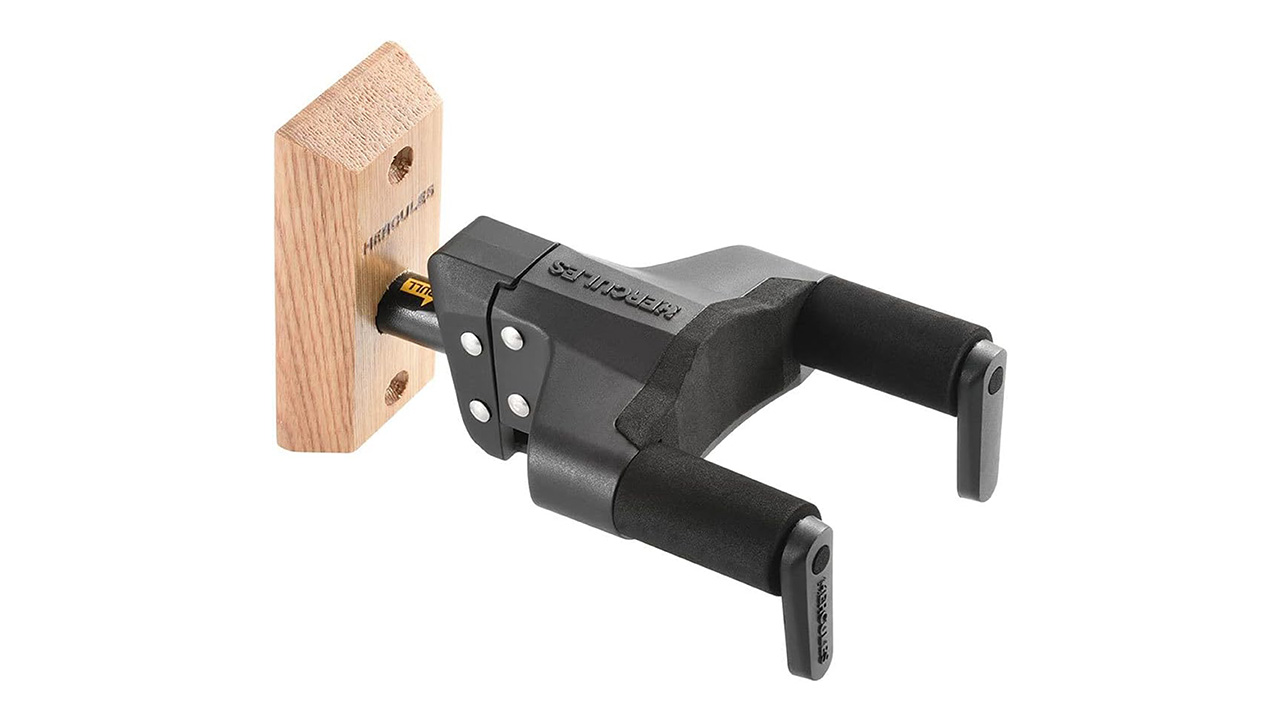
1. Hercules GSP38W
Our expert review:
Specifications
Reasons to buy
Reasons to avoid
✅ Buy if you want the safest wall hanger out there: The locking clips that are weight-activated will save your guitar from crashing down.
❌ Avoid if you don’t have a solid beam to drill into: You won’t want to drill this into plasterboard; instead, find a solid wall or a beam to keep it totally secure.
Overview: If you've ever seen a guitar hanging on a wall, there's a good chance it was supported by a Hercules hanger. Trusted by players everywhere, this hanger is a simple but reliable way to keep your instrument safe while also freeing up floor space. It's particularly popular for home setups where guitars double as decoration as much as instruments.
Build Quality: The GSP38WB features a sturdy plastic hanger mounted on a smart wooden base that'll suit most decors. Like Hercules’ stands, this wall hanger is built to last, offering strength and stability that inspires confidence. The hanger arms are designed to move upward when weight is applied, locking the guitar securely in place.
Usability: Installation is required, but once it's mounted, the GSP38WB is easy to use and offers peace of mind. The auto-locking mechanism helps prevent accidents from knocks or bumps, making it a dependable choice if you want your guitar accessible and on display.
It's an ideal option for players looking to save space without compromising on safety. Plus, Hercules has made this nitro-safe, so hanging your Gibson won’t cause any issues.
Best multi
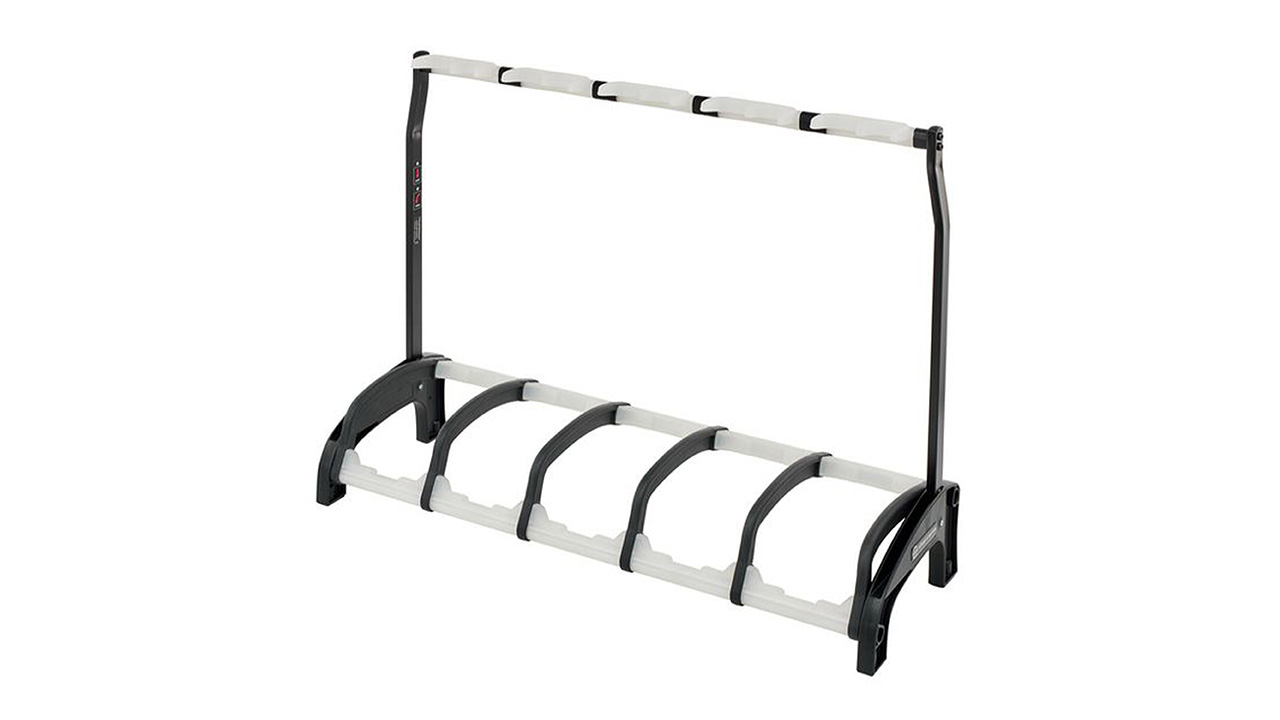
2. K&M Guardian
Our expert review:
Specifications
Reasons to buy
Reasons to avoid
✅ Buy if you have electric, acoustic and bass guitars: The wide base design will accommodate different body shapes, sizes and styles with ease.
❌ Avoid if you prefer adjustable cradles: Other brands offer this feature and you find it useful for organizing your guitars.
Overview: If you own multiple expensive or vintage guitars, the K&M Guardian is one of the safest and most stylish ways to keep them on display and within easy reach. Its wide base design accommodates electric, acoustic, and bass guitars of varying shapes and sizes, making it a versatile choice for serious collections.
Build Quality: The Guardian stands out for its exceptional construction. The contact points contain no dye and are covered in a soft, non-marring material, so you'll not need to worry about marks or finish damage, even on nitrocellulose-coated guitars. The stand is solid and stable, with a reassuring sturdiness that reflects its higher price.
Usability: Although the neck cradles aren't adjustable, the stand works well across most common body shapes and sizes. The rubberized contact surfaces add extra peace of mind, helping protect instruments even if they're set down quickly or with a bit more force than intended. For players with multiple guitars, this rack is an excellent way to keep a collection organized and safe.
Best acoustic
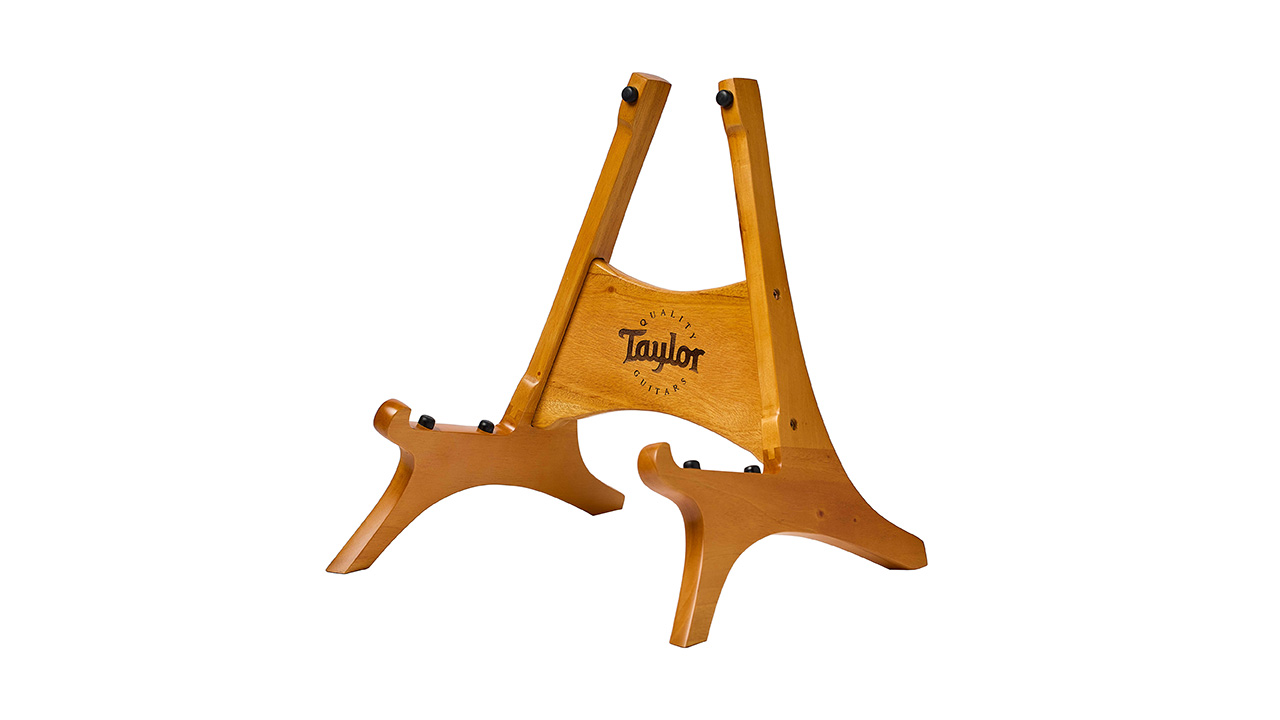
3. Taylor Guitar Stand
Our expert review:
Specifications
Reasons to buy
Reasons to avoid
✅ Buy if you want your Taylor to shine: Having the branded wooden stand is the best way to show off a beautiful Taylor acoustic, plus, this will work with all of Taylor’s body shapes.
❌ Avoid if you are looking for something versatile: Unfortunately, this isn’t going to work for electric or bass guitars. Look elsewhere if you don’t have an acoustic.
Overview: If standard black plastic or metal stands do not do justice to your instrument, the Taylor Guitar Stand offers a more elegant solution. Designed specifically to complement Taylor’s acoustic guitars, it is available in two shades of mahogany and pairs beautifully with the natural look of an acoustic guitar and your living space.
Build Quality: Constructed from solid mahogany, this stand is sturdy and built to last. Rubber pads at each contact point protect the guitar from scratches or scrapes, so you can display your acoustic with confidence. The overall design feels premium and matches the craftsmanship associated with Taylor guitars.
Practicality/Usability: This stand is not nitrocellulose safe, so owners of such guitars will need to be cautious; albeit, Taylor doesn’t tend to opt for nitro. It is also designed exclusively for acoustic guitars, so it will not suit electric or bass models. However, it is compact and will fit into most spaces that you are likely to want to display a guitar. If you own a Taylor acoustic and want a stand that shows it off at its best, this is a stylish option worth the extra cost.
Best electric
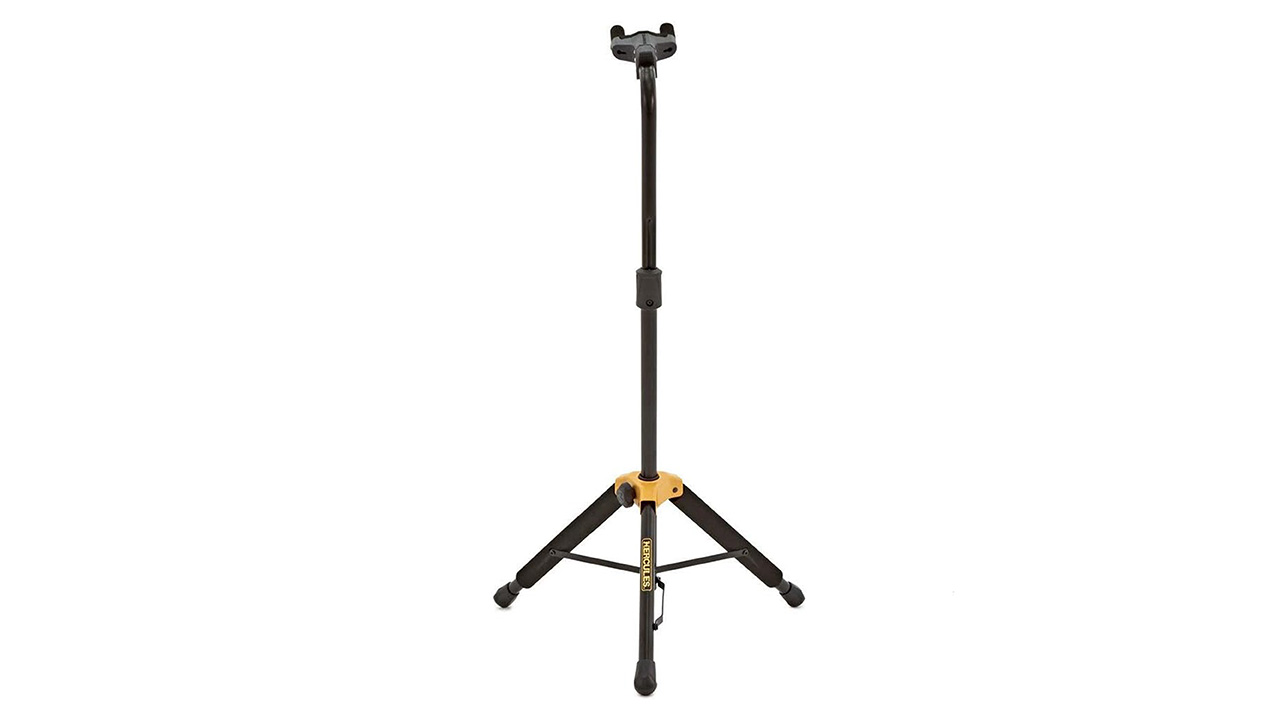
4. Hercules GS414B Plus
Our expert review:
Specifications
Reasons to buy
Reasons to avoid
✅ Buy if you want to upgrade from something basic: The GS414B Plus is premium, offering locking security and plenty of protection. It’s a great choice if you're looking for something nicer than the basic.
❌ Avoid if space is a premium: The tripod legs take up more room than usual, so it's not ideal for smaller spaces.
Overview: If you are after a single guitar stand you can completely trust, and you aren't too concerned about it being super portable, then the Hercules GS414B Plus has to be one of, if not the best, guitar stands out there.
Build Quality: The three legs give it great stability, but then the rubber feet on each of them create more friction against the ground. Although if the area is a premium in your space, it may not be the best solution for you, as the legs protrude and take up more room than usual.
It's generally fine with nitro finishes, as long as the finish has been cured properly – many Gibson dealers use Hercules hangers or stands without any issues.
Usability: There's then of course the auto-grab feature that Hercules stands are well known for. Simply rest the headstock in the slot, and the weight of it will cause the two arms to lock it in place. The body then rests against a padded material on the two front legs.
Best for bass
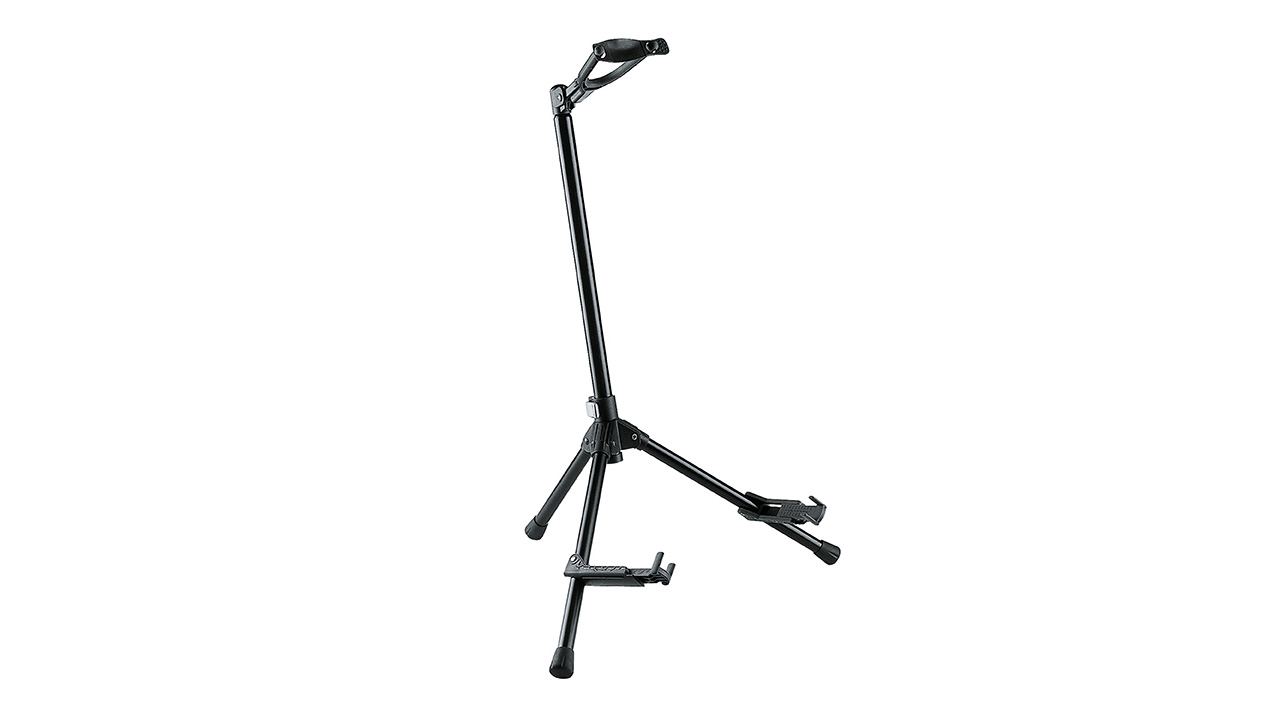
5. K&M 17685 Memphis 20
Our expert review:
Specifications
Reasons to buy
Reasons to avoid
✅ Buy if you’re looking for single-stand versatility: With adjustable lower supports, this works well for bass guitars of all sizes and body shapes.
❌ Avoid if you want the best quality latch: The latch at the neck cradle isn’t automatic, nor is it the best quality on the market.
Overview: If you want a reliable stand that can comfortably support a bass guitar, the K&M 17685 Memphis 20 is a great choice. It brings together a mix of useful features that make it versatile and dependable without being over-engineered.
Build Quality: Although it doesn't carry the largest price tag on my list, the Memphis 20 is solidly built and easily strong enough to handle heavier instruments. The adjustable lower supports give it the adaptability to accommodate a wide variety of body shapes and sizes, which is particularly useful for bass players with different styles of instruments.
Usability: The combination of a hanging system and two support arms gives this stand excellent stability. Its adjustable height works well for different scale lengths, and the safety strap at the neck cradle provides extra security. On top of that, the stand collapses for easy transport, making it a practical option for both home and stage use.
Best double
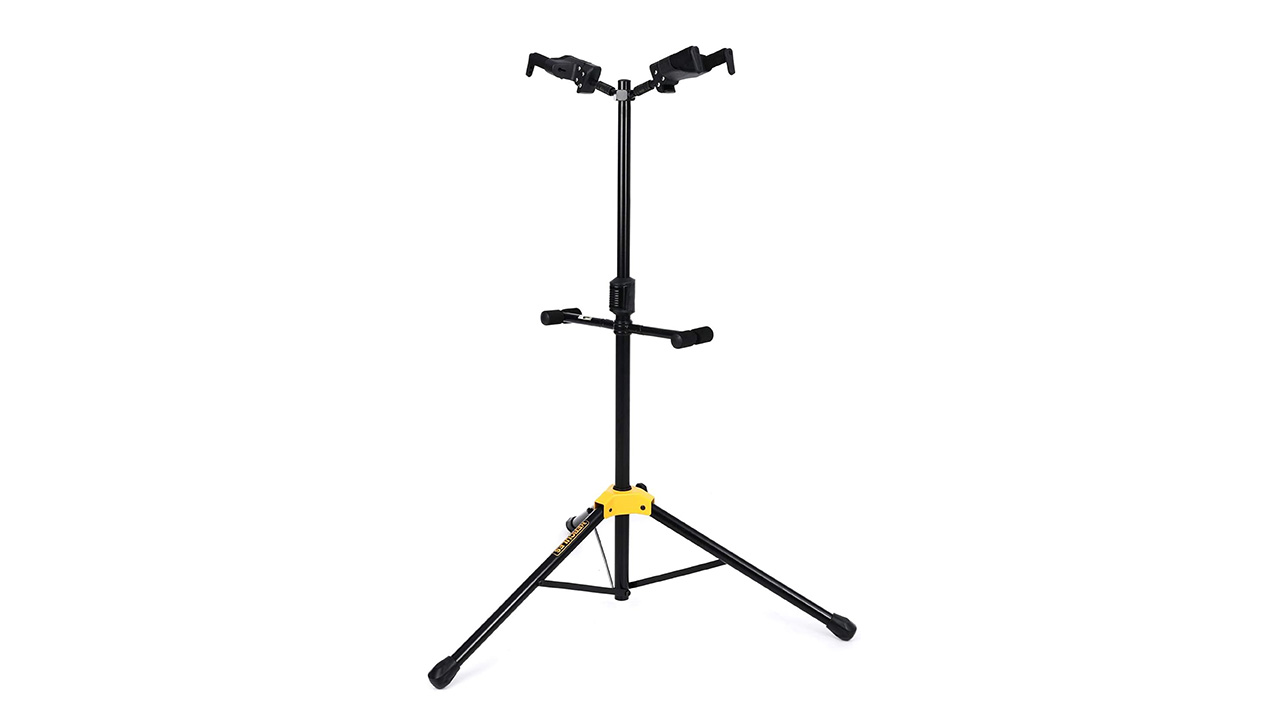
6. Hercules GS422B PLUS
Our expert review:
Specifications
Reasons to buy
Reasons to avoid
✅ Buy if you switch between two instruments in a performance: This is a great design for the players who switch between an acoustic and an electric often.
❌ Avoid if your instruments are quite imbalanced: The GS422B PLUS can become wobbly when lifting an instrument off, so this may not suit a bass and a mandolin.
Overview: If you need a double guitar stand for gigs or home use, the Hercules GS422B PLUS is one of the best options around. Designed to hold two guitars back-to-back, it's a compact and dependable stand that showcases the features Hercules is known for.
Build Quality: This stand delivers the rugged construction and stability associated with Hercules. The instant height adjustment clutch makes it easy to fit guitars of different lengths, while the included narrow instrument neck adjustment allows the cradle to accommodate smaller instruments such as banjos or mandolins.
Usability: Hercules’ AGS system is present here, automatically adjusting to the size of your headstock for a secure fit. The stand folds for portability, which makes it ideal for shows, though it is worth noting that some players report less stability when only one guitar is on the stand. With both guitars in place, however, it offers excellent security and ease of use.
Best portable
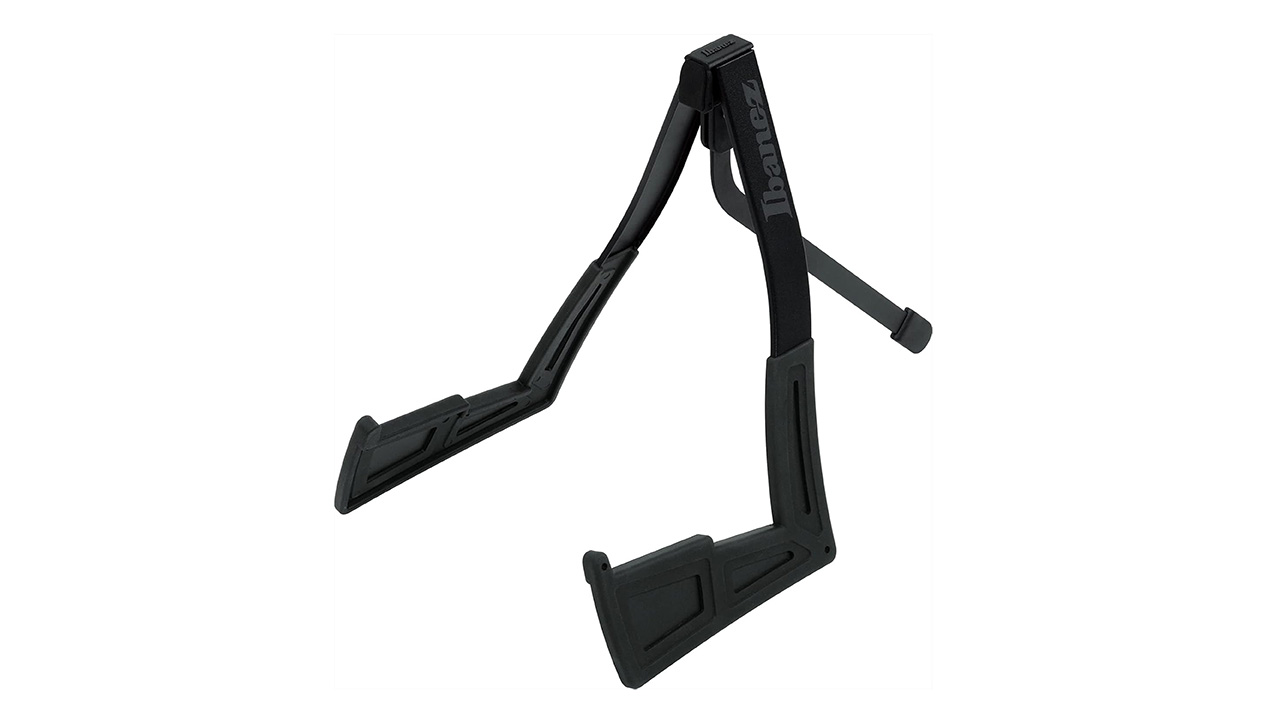
7. Ibanez ST101
Our expert review:
Specifications
Reasons to buy
Reasons to avoid
✅ Buy if you want to keep your gigging guitar safe: How many times has your guitar taken a dive when resting against an amplifier at a gig? Well, the ST101 is the answer.
❌ Avoid if you value durability: It isn’t the best quality stand out there, so you may want something more durable and premium for your pride and joy at home.
Overview: Picture this: you've finished soundcheck and need to set up the merch stall. Where does your guitar go? For many, the answer is leaning against an amplifier. Two steps away and you hear a crash; your guitar is now face down on the floor. Sounds familiar? If so, the Ibanez ST101 stand could be the solution.
Build Quality: The ST101 is not the most robust stand, so it might not be the best choice for your most valuable guitar (MVG) at home. However, for players on the move who need something compact and practical, it does the job well. It's a clear improvement over leaving your guitar propped against an amp or drum riser, and it barely takes up any space.
Usability: This stand is especially handy for gigging musicians. It folds down small enough to fit inside many gig bags or backpacks, and setup is quick and simple. Just unfold it, pull out the supporting leg, and it's ready to use. For portable convenience, it's hard to beat at the price.
Best for nitro
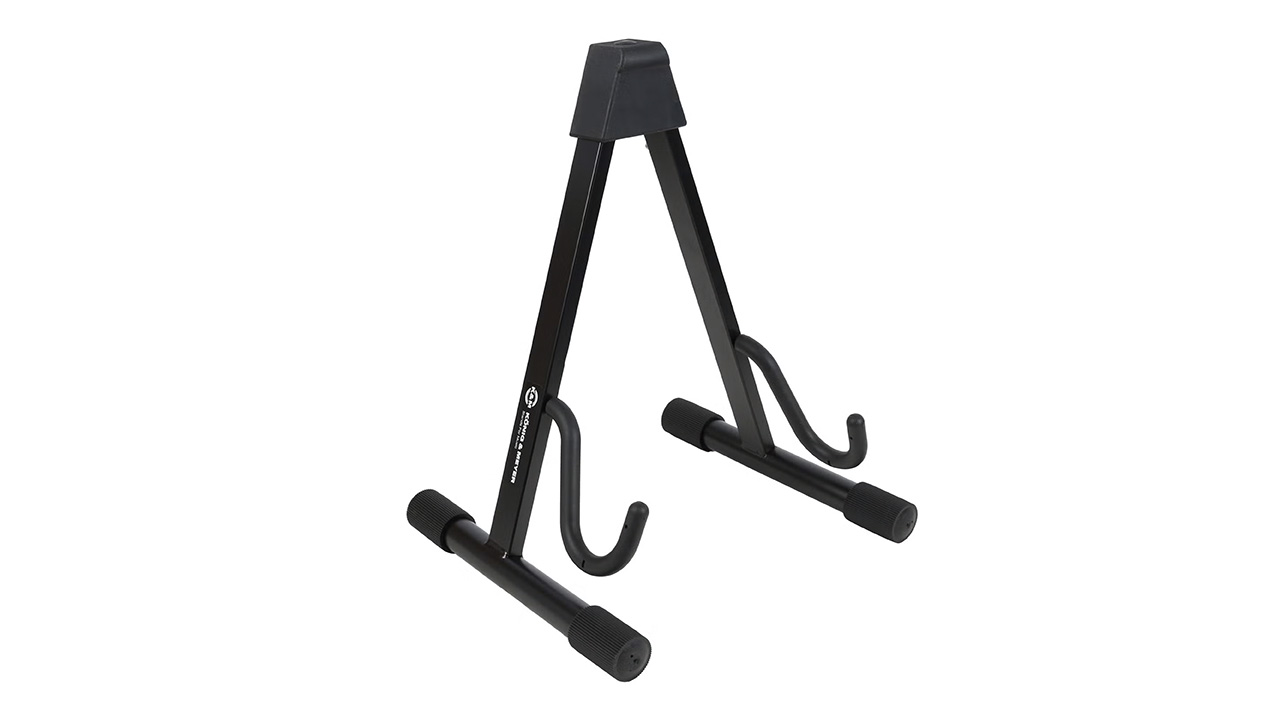
8. K&M 17540
Our expert review:
Specifications
Reasons to buy
Reasons to avoid
✅ Buy if you fear the dreaded lacquer burn: This is no joke; the chemical reaction between untreated rubber and nitrocellulose can leave an indelible mark on your expensive guitar.
❌ Avoid if you don’t have a nitro guitar in your collection: If you don’t, it is an unnecessary price to pay for an A-frame stand.
Overview: This is a very simple stand and, though it doesn’t offer any neck support, it’s good for players who maybe don’t have a lot of space, or want something they can travel with easily. Probably its biggest plus point, however, is the fact that it’s nitro-friendly.
Build Quality: The contact points of this stand are covered in a translucent non-marring plastic material so that you don’t get any unwanted marks or discoloration on your instrument, regardless of the finishing process it’s gone through.
You can get them either for an electric guitar or an acoustic – they have been designed to accommodate the thicknesses of the bodies, especially so that they’re more secure when in place.
Usability: At its core, this is a fairly simple A-frame stand. It offers a level of compactness that tripods can’t, and it's very stable, regardless of having no neck support. When you're not using it, you can fold it away, which may come in handy when transporting it. Overall, it's an uncomplicated stand that does the job well.
Best premium
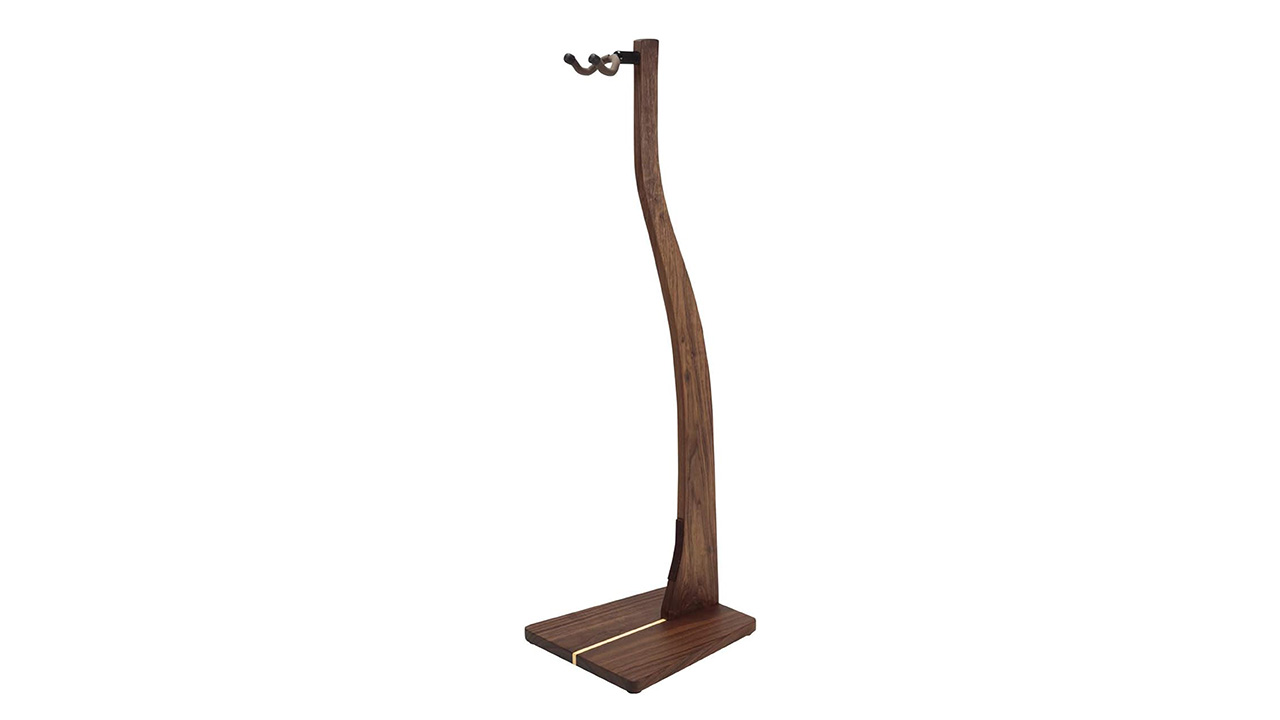
9. Zither G04
Our expert review:
Specifications
Reasons to buy
Reasons to avoid
✅ Buy if you value craftsmanship: Albeit fulfilling a humble task, why can’t your guitar stand be as meticulously crafted and sought-after as your guitar?
❌ Avoid if you are on a strict budget: Attention to detail, craft and high-quality materials obviously come with a hefty price tag.
Overview: The Zither G04 handcrafted wood guitar stand is arguably one of the best-looking stands available and the walnut finish is my personal favorite. If you own a premium guitar, this serves as a worthy throne for it to rest upon.
Build Quality: Crafted from premium solid wood, the G04 is not only durable but also showcases a unique wood grain pattern, ensuring no two stands are exactly alike, which adds to that distinctly luxurious feel. Zither even includes a bottle of lemon oil.
Practicality/Usability: Featuring a string swing cradle design, it provides 38 inches of hanging room, making it suitable for most acoustic and electric guitars. However, this is no small stand; with such quality and craftsmanship, it's designed to take center stage and will fill up a small space. Plus, this level of high-end craftsmanship comes at a cost, and the Zither G04 is a sizeable investment.
How to choose
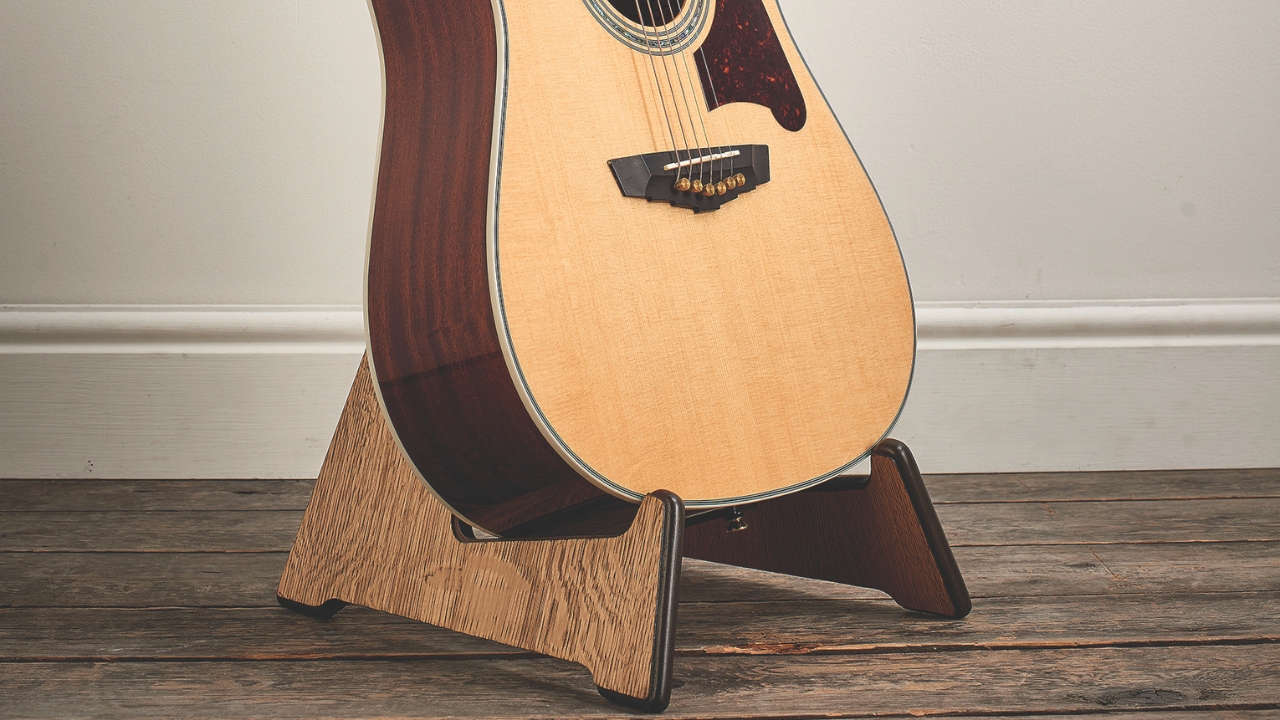
Although guitar stands and hangers carry out a simple task, there are a few features you will want to consider before making a purchase. I've been helping musicians for the best part of a decade select the right option, and this is the process I take them through when they walk into the guitar store I work in.
1. Stand or hanger
You can trust Guitar Player.
This is a basic first step, but an important one. What will suit your space better, a stand or a hanger? Both have pros and cons. A guitar stand requires less setup; you do not have to screw it to the wall, and it can be moved around the house to your liking. They are also available as multi-racks to store several guitars at once.
Wall hangers, on the other hand, are a brilliant way of displaying your guitar. They keep it safely off the ground, out of the way of pets, small children, or accidental knocks. If floor space is limited, hangers make great use of otherwise dead space on your walls. Just be sure you are screwing into a solid wall; otherwise, it will come tumbling down as soon as you hang up your guitar.
2. Material
Next up, consider what material the stand is made from. This is particularly important if you have a guitar finished in nitrocellulose lacquer. Nitrocellulose can react with untreated rubber in a devastating way. Known as lacquer burn, this chemical reaction can leave marks, blemishes, or even melt the finish.
If you own a nitro-finished guitar, it is essential to choose a stand or hanger specifically labeled as nitro safe. Polyurethane lacquer, which is the most common finish used today, will not react in the same way with untreated rubber.
3. Number of guitars
As mentioned, stands can come in multi-rack formats, ideal if you need to house more than one instrument. For players with larger collections, a multi-guitar rack can be a game-changer. They keep everything organized, cut down on clutter, and often take up less space than several single stands.
Buying one multi-rack can also save you money in the long run compared with buying multiple single stands over time. If you only own one guitar, though, a simple single stand or hanger will be more practical.
FAQs
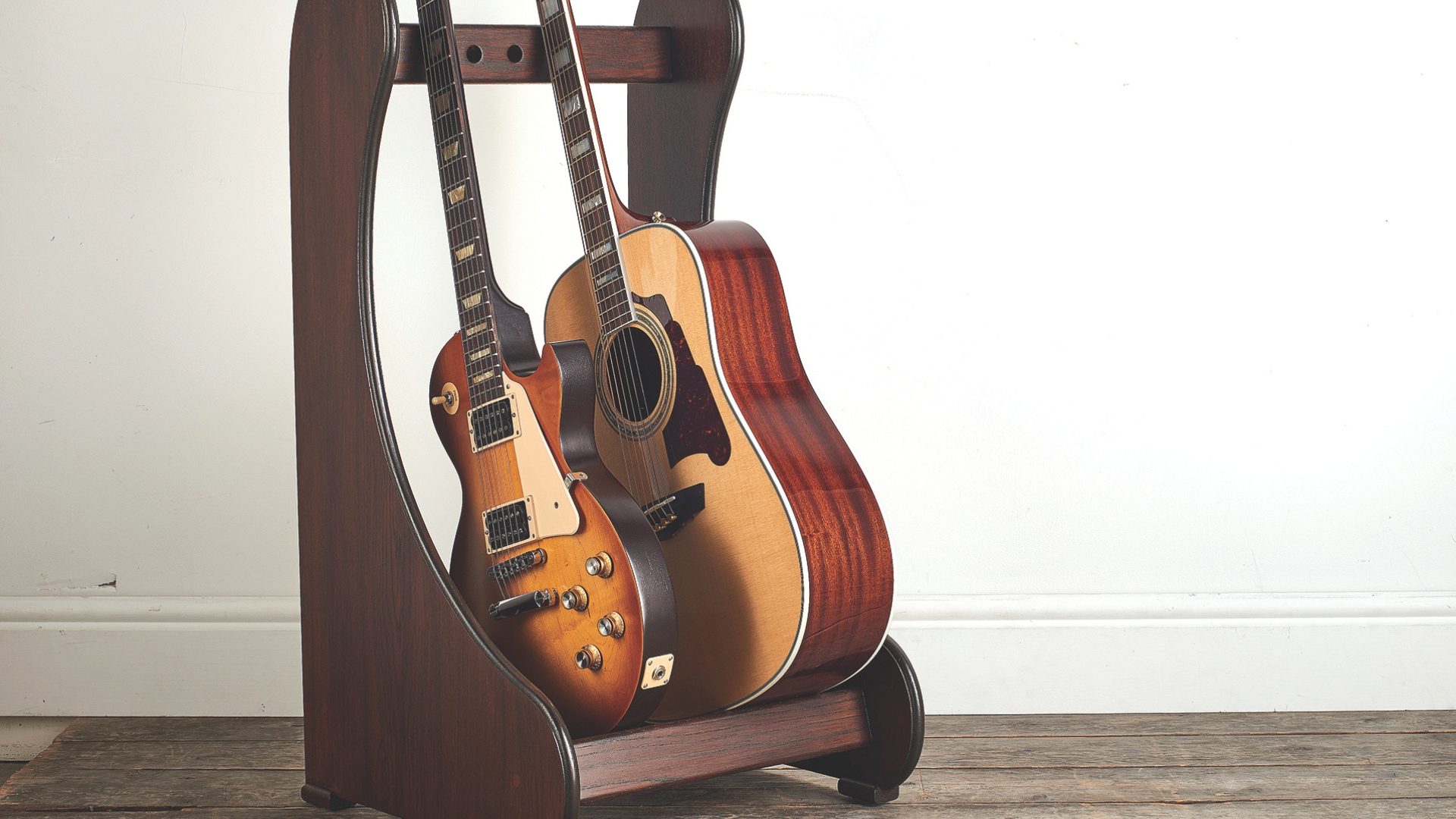
Are stands and hangers safe for nitrocellulose finishes?
Not all guitar stands and hangers are safe for nitrocellulose finishes. Untreated rubber, which many stands and hangers use, can react with nitro lacquer and leave a blemish, mark, or in some cases even melt the finish. This doesn't usually happen immediately, as the reaction depends on certain conditions, but it's a very real issue that's affected plenty of high-end guitars. If you own a nitro-finished guitar, make sure you choose a stand or hanger that's specifically labeled as nitro safe to protect your finish.
Is it OK to hang a guitar by the headstock for long periods?
Yes, provided your hanger is secured into a solid section of wall or a beam, it's safe to hang your guitar for long periods of time. In nearly 10 years of working in a guitar store, the only times I've seen guitars fall overnight were due to walls crumbling, not the hangers themselves. In my experience, a guitar won't suffer neck or headstock damage simply from being hung. The only exception might be if the instrument has previously had a neck or headstock repair, in which case extra caution is advised.
Is a wall hanger or a floor stand better?
There's no single answer here, as the better option depends on your needs. Wall hangers are a great way to save space in smaller rooms, keep guitars out of reach of children or pets, and display your instruments like pieces of art. The trade-off is they require proper installation into a secure wall, they aren't portable, and they don't come in multi-rack formats.
Floor stands, by comparison, require no installation, are portable, and can hold multiple guitars if needed. They're also generally more affordable. However, they take up more space on the floor and leave your guitar within easier reach of curious children or pets.
Do I need studs for my wall hanger or will drywall anchors work?
From my experience, I'd always recommend using studs for your wall hanger. Most of the falls I've seen over the years came from hangers fixed with drywall anchors. Some players use drywall anchors successfully, and lighter guitars or smaller acoustics can often be held that way, but I don't think it's worth the risk. For maximum security and peace of mind, always use a stud.
Which stands are best when you have kids or pets?
It's always great to encourage kids’ curiosity about instruments, but sometimes they don't need to be climbing on your Martin D-28. In my experience, multi-guitar racks are the best option if you have children or pets. They generally offer better balance and stability, so they're harder to knock over. Single stands, on the other hand, can tip more easily if bumped. Even better is a multi-guitar rack with neck locks, which adds an extra layer of protection and makes it much harder for a child to pull a guitar down.
Do auto-grip stands work with all headstocks?
For the most part, auto-grip stands will work with almost any headstock. The main thing to watch out for is nut width. I've seen some classical guitars sit awkwardly on auto-grip stands because their nut is too wide to fit comfortably, preventing the grip from closing fully. The same problem can happen if the nut width is too slim, as the grip may not engage properly. Most electric guitar nut widths are fine, and because the grips attach to the curved bottom of the headstock, different headstock shapes are usually not an issue.
What about offsets, V guitars, or headless guitars?
The biggest challenge with offsets and V-shaped guitars is at the base. Auto-grip stands secure the instrument at the neck, so they'll hold offsets and Vs fine at the top. The issue is at the bottom: many stands are designed for standard guitar shapes, and the lower body may not sit securely on the rests, which can cause balance problems.
Headless guitars bring a different issue. Since auto-grip systems rely on the curvature of a headstock to engage, a headless design gives the mechanism nothing to grip. Without that anchor point, the locking action won't work.
Does storing a guitar on a stand affect humidity?
Yes, keeping your guitar on a stand makes it harder to control humidity. A closed case provides a smaller, sealed environment where you can regulate conditions with humidity control devices. The case also acts as a barrier against sudden changes in temperature and moisture. On a stand, your guitar is exposed to the room’s ambient humidity, which makes maintaining specific conditions more of a challenge.
Do guitar stands wear out over time?
Yes, guitar stands can wear out over time, especially if you use them daily. The areas most likely to show wear are the rubber sections where the lower bout rests. Years of picking up and setting down your guitar can cause these to break down. If the rubber wears through and exposes bare metal, it could damage your instrument. The good news is that well-made stands are built to last, and with proper care, a quality stand can serve you reliably for decades.
Key terms

- A-frame stand: This is a type of singular floor stand with a compact profile that doesn't feature a neck cradle. Instead, you rest the guitar on its base.
- Auto grip: An auto grip stand features a mechanism that'll secure your guitar in place by using rotating grips. An auto grip tends to be weight-activated.
- Drywall anchor: A type of anchor that's designed to distribute the weight for hanging heavy objects on plasterboard, like a guitar.
- Headstock cradle: This is an accessory that supports your guitar’s headstock, typically when on the workbench to stop it from slipping.
- Load rating: This is the maximum amount of weight a guitar stand can take before breaking.
- Neck warp: This is the part of a guitar stand that wraps around the neck, or underneath the headstock, where you can securely rest your guitar so it is stable and doesn't slip.
- Nitro-safe: A guitar hanger or stand considered ‘nitro-safe’ is one that's been treated so it doesn't chemically react with nitrocellulose lacquer.
- Stud mounting: Fixing a guitar hanger directly into a wall stud, rather than plasterboard, to ensure maximum security and avoid accidents.
How we test
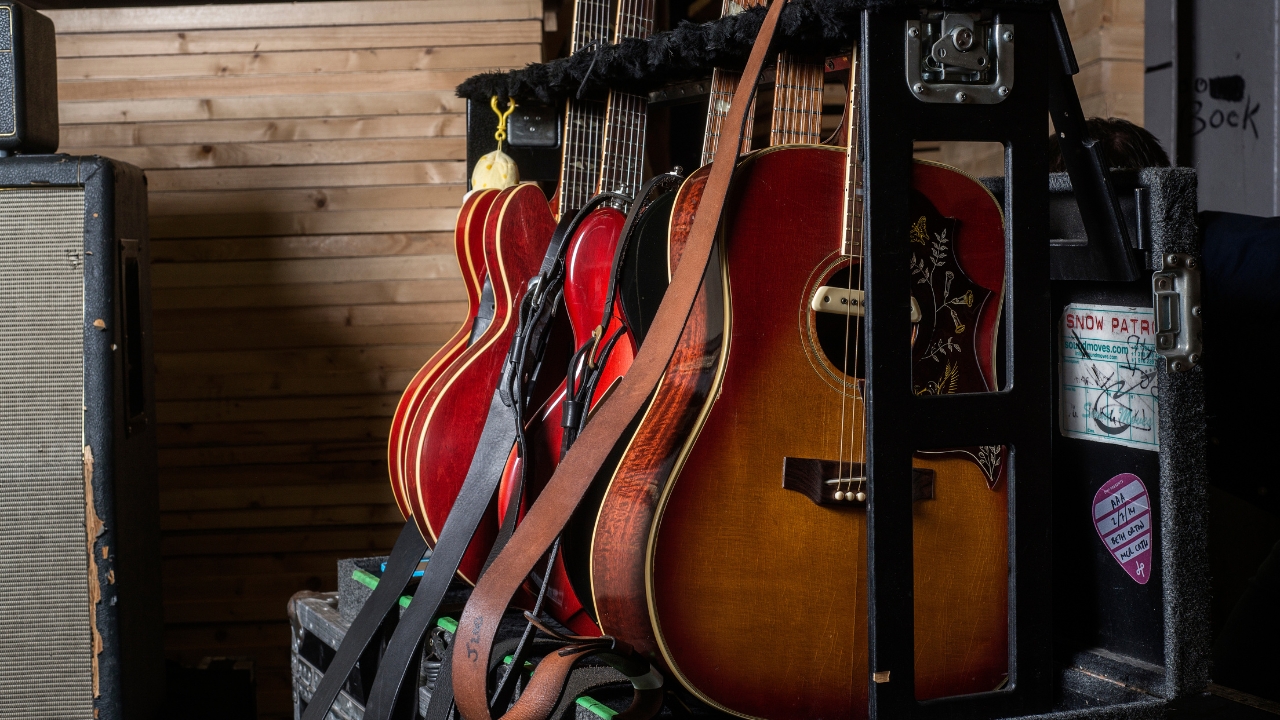
When testing a guitar stand there are a few things we need to take into account before they can make it into one of our guides. Despite being a simple device a guitar stand does a very important job, and you're placing a lot of trust in one when you put your guitar on or into it.
First and foremost we'll look at how easy it is to set up. Some a-frame stands just need to be opened but guitar hangers require installation. In this case, we'll look at how easy it is to mount it on the wall, whether you get all the tools you need or not, as well as how clear the instructions are for installation. With floor stands we'll look at how easy they are to put together once out of the box, do you get everything you need in the box to put them together and is everything clearly marked?
Once this is done we'll use the stand with a variety of guitars to see how well it suits different instruments. In the case of a guitar hanger, we'll be looking at how securely it huge the instrument headstock, and whether the wall attachment feels solid enough that we'd trust our own instruments with it.
Floor stands get a similar treatment, but we'll look at how stable they are on the floor and in the case of multi-stands, whether they're still as stable when only partially full. We'll also look at the collapsible aspect of these stands, how easy they are to take down and put up, and whether you'd find it easy to do it on a dark stage.
Read more on how we test gear and services at Guitar Player.
Meet the experts

After spending a decade in music retail, I’m now a freelance writer for Guitar World, MusicRadar, Guitar Player and Reverb, specialising in electric and acoustic guitars, bass, and almost anything else you can make a tune with. When my head’s not buried in the best of modern and vintage gear, I run a small company helping musicians with songwriting, production and performance, and I play bass in an alt-rock band.

Connor is a contributor to Guitar World and MusicRadar. Having been a guitarist since the age of 10, he's played bass and guitar in bands across the South West of England. He has a background in audio engineering, having worked in some of the UK’s best studios including Rockfield and Invada, and has a passion for recording guitar. He is always keen to discover the greatest gear for capturing tone, be that microphones, audio interfaces or cab simulators.

Ross has been a music lover and guitar player since the age of 8. He has spent the five years since graduating from university working in music retail, selling guitars, amps and more. Ross is particularly interested in electric guitars, pedals and amplifiers and his current rig includes a trusty 2009 American Standard Stratocaster and Vox AC30S1 with a few Walrus Audio and Way Huge pedals in between.

Matt is a Junior Deals Writer here at Guitar Player. He regularly tests and reviews music gear with a focus on guitars, amps, pedals, modelers, and pretty much anything else guitar-related. Responsible for over 60 buying guides, a large part of his role is helping guitarists find the best deals on gear. Matt worked in music retail for 5 years at Dawsons Music and Northwest Guitars and has written for various music sites including MusicRadar, Guitar World, Guitar.com, Ultimate Guitar, and Thomann’s t.blog.
Latest updates
12/09/25: The guide has been rebuilt to expand on all nine of the guitar stands and hangers and now features detailed product explanations and "At a glance" boxes. The FAQ section has been completely rewritten, while new sections highlighting key terms and how to choose the right guitar stand have also been included. A "meet the experts" section has also been added.
Read more
- Sound great with the best guitar cables
- Add some dynamics with the best guitar slides
- The best guitar capos are an essential item
- Freshen up with the best electric guitar strings
All the latest guitar news, interviews, lessons, reviews, deals and more, direct to your inbox!
After spending a decade in music retail, I’m now a freelance writer for Guitar Player, Guitar World, MusicRadar and Reverb, specializing in electric and acoustic guitars bass, and almost anything else you can make a tune with. When my head’s not buried in the best of modern and vintage gear, I run a small company helping musicians with songwriting, production and performance, and I play bass in an alt-rock band.
- Connor Godfrey
- Ross Holder
- Matt McCrackenJunior Deals Writer

